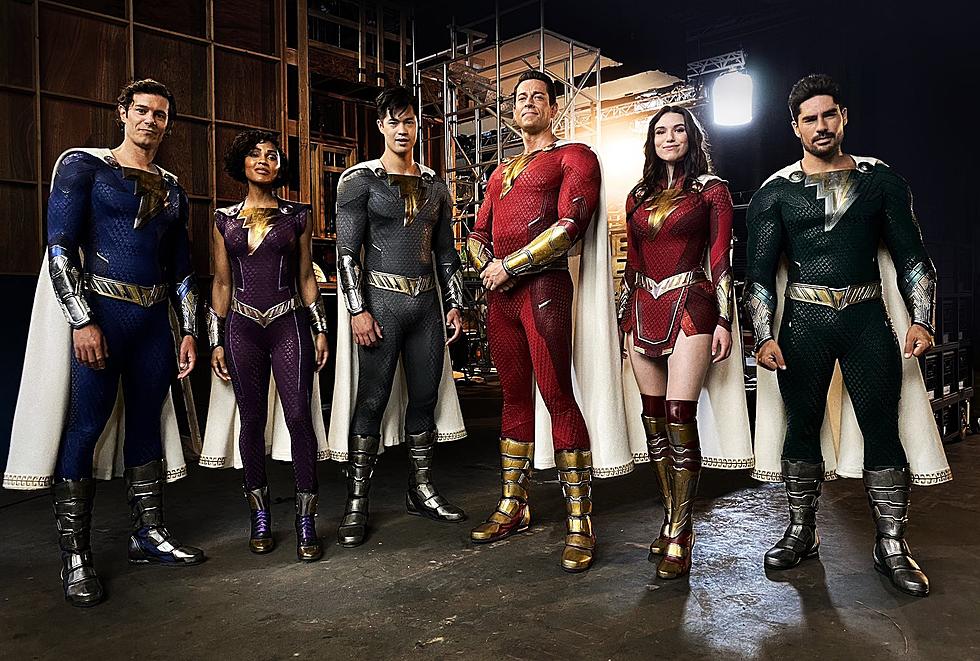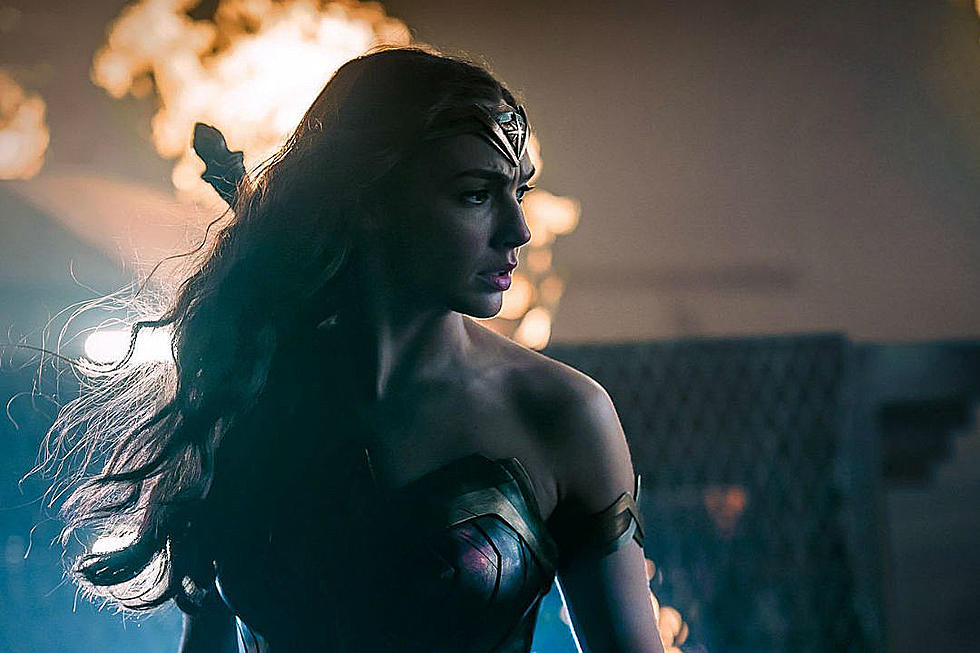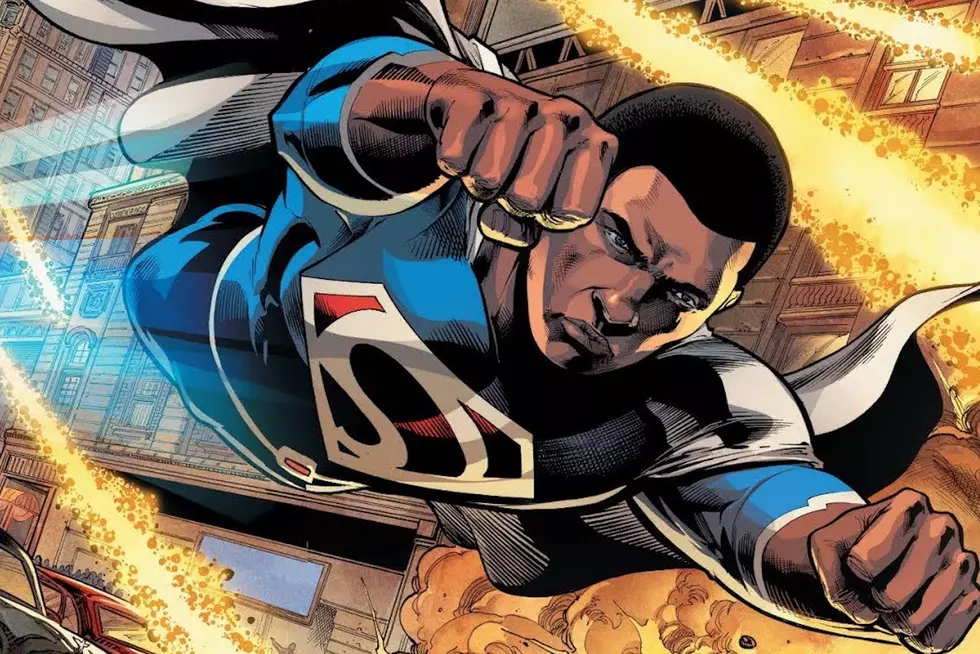![Trinity War Correspondence, Week One: Life, Death and Maybe-Death [SPOILERS]](http://townsquare.media/site/622/files/2013/07/5iEhSQi28l7ASSfa2BBAIPSlXJ2__R6pnKSfRzlbmlc.jpeg?w=980&q=75)
Trinity War Correspondence, Week One: Life, Death and Maybe-Death [SPOILERS]
What is Trinity War? A long-teased, long-foreshadowed and long-hyped DC Comics crossover event story devised by the company's most popular and most influential (and most handsome, to hear some tell it) writer, Geoff Johns. The story prominently features Pandora, the mysterious, sometimes glowing lady with the hood who created The New 52iverse in the concluding chapter of Johns and Andy Kubert's 2011 event series Flashpoint, and subsequently appeared in all 52 first issues of DC's relaunched superhero line. As such, Trinity War may finally explain what exactly The New 52 is really all about (aside from a whimsical preoccupation with the number of weeks in a year and a questionable predilection for Nehru collars).
What does the "Trinity" in the title refer to? DC usually uses that word to refer to their "Big Three" heroes: Superman, Batman and Wonder Woman. Will they be going to war with one another? Over what? (Maybe romance? You know, Superman and Wonder Woman are dating now, but in the old universe she and Batman dated for, like, an issue of JLA sooooo...). Could the title refer to the "Trinity of Sin," a trio of cosmic wrongdoers including Pandora, The Phantom Stranger and The Question? Is the titular trinity a reference to the three Justice Leagues (Of America, Dark and Original Recipe)? Are they gonna fight?
After more than a year-and-a-half of waiting, we finally found out when Trinity War kicked off in earnest with this week's Justice League #22 and we're going to tell you all about in the first installment of ComicsAlliance's Trinity War Correspondence!
Before we check in on the League vs. League action in Justice League #22, we better see what Pandora's up to in her title, as it says "A Prequel To Trinity War" right there on the cover despite the fact that this is not actually a "prequel" at all but rather a prelude.
Trinity of Sin: Pandora #1
Written by Ray Fawkes
Art by Zander Cannon, Daniel Sampere, Vicente Cifuentes, Patrick Zircher and Hi-Fi
You all know the myth of Pandora right? The very first woman, she was created by the Greek gods and then, either out of curiosity or divine-driven spite or simply just because women were always causing so many problems back in those male-written creation myths, she opened a box that released all evil and suffering into the world. Well, not in the DC Universe!
In the New 52, Pandora began life in a village of hunter-gatherers around the year 8,000 BCE. We first see her caring for a sick little boy (so you can't pin sickness on Pandora! That was there before she opened any boxes!) but one day, she comes upon a shiny object that turns out to be the "O" from her very own logo: a three-eyed golden skull. She picks it up and the skull opens itself -- which deviates rather strongly from the original myth, because here Pandora was essentially in the wrong place at the wrong time. Out of the skull pour the Seven Deadly Sins -- Envy! Gluttony! Price! Greed! Sloth! Wrath! Lust! 1-in-250 Variant Covers! -- and they proceed to gorily murder and devour Pandy's whole village (this comic book is rated "T")
For her unforgivable transgression of, well, picking up the skull tchotchke, Pandora is summoned to the Rock of Eternity along with two other dudes (the Question and the Phantom Stranger, although they don't look like themselves yet [if the Question can really look like anybody]). There they encounter the Wizard Shazam (not to be confused with the superhero Shazam, who was formerly known as Captain Marvel, which is obviously much more confusing than to have to write this same phrase in parentheses any time either character is mentioned evermore). Shazam judges them "the greatest transgressors mankind has ever known" and, along with three mysterious ladies sitting in uncomfortable rock chairs next to him, he sentences this trinity of sinners (ah ha!) to walk the Earth as immortals, forever witnessing the damage they have wrought.
For Pandy, this means watching her progeny -- the personified Seven Deadly Sins actually call her "mother" -- ravaging mankind through their corrupting influence.
(It should be noted that they are not all bad: the Sins do invent the hat thousands of years earlier than mankind was thought to have developed hat technology, with Envy sporting a top hat in 7000 BCE, and Greed a bowler or derby in 6000 BCE.)
After a few thousand years of putting up with the Sins, Pandora starts to wander the Earth on her own, training her body and mind Batman Begins-style. It's not until this year, 2013, that Pandora finally figures out how to stop the Sins: by shooting them in the head. With bullets.
But before she can shoot them all in their heads with bullets, Shazam (wizard, not ex-Captain Marvel) summons Pandora to a rainy alley and delivers some crucial exposition with his dying breath: After 10,000 years he realized he might have been a little hard on her, so Shazam obliquely reveals that the way to end her curse has something to do with the golden skull, and that she's going to have Superman open it for her because he's strong and pure of heart (and his books sell better than Animal Man or Vibe).
And that's that; we've just been prequeled preluded! Time for the main event! Or the first part of the main event, anyway.
Justice League #22
Written by Geoff Johns
Art by Ivan Reis, Joe Prado, Oclair Albert and Rod Reis
Super-fortune teller and refugee from the canceled Demon Knights title Madame Xanadu receives a distressed woman in her fortunetellery (or whatever the shops where fortune tellers tell fortunes are called), but instead of reading the woman's future, Xanadu sees glimpses of future scenes from Trinity War. In this vision: Superman, Wonder Woman and Batman -- the DC trinity -- looking down at a flaming city in ruins. Madame Xanadu starts flipping her special DC Universe pack of tarot cards (which maybe someone at DC Collectibles is already working on; the Vertigo tarot from back in the day was awesome), revealing various players in the unfolding story.
For example, there's "The Boy" -- Shazam (formerly Captain Marvel, not the late wizard who died in Pandora #1), who has decided to fly into Khandaq, the go-to fictional Middle Eastern nation of the DCU, to spread the ashes of his cremated enemy Black Adam.
And then there's "The Hero" and "The Warrior" -- Superman and Wonder Woman, respectively. When we meet them here, the super-couple are arguing over whether Despero should be kept in supervillain jail or if Wonder Woman shouldn't maybe just stab him to death. You know, the kind of stuff couples talk about.
"There's a reason I don't have a list of villains as long as Batman's, the Flash's or even yours," Wonder Woman says. "When I deal with them, I deal with them." Having read over 20 issues of Wonder Woman since the New 52 relaunch, I have an alternate theory as to why she doesn't have a list of villains: she really only fights the grosser members of her own immortal Olympian god family. Anyway, the increasingly heated discussion about capital punishment is interrupted by the arrival of Pandora and her skull-box. Pandora asks Superman to open the box per Shazam's (the wizard, not the former Captain Marvel) instructions, but when he touches it Superman grows a third eye, turns grey, freaks out and attacks both ladies until he happens to drop the skull and resets.
The conflict is interrupted by news that Shazam (formerly Captain Marvel, not the dead wizard) has entered Khandaq, and the nation has pointed its military forces right at him. The Justice League travels to Khandaq to escort Shazam away before the international incident becomes more internationally incidental. But then the Justice League of America -- the more "hardcore" team of generally weaker characters (Green Arrow! Catwoman! Vibe! Steve Trevor!), a team specifically assembled, paradoxically, to take down the more powerful Justice League if they ever go rogue -- goes to Khandaq to escort the Justice League out of Khandaq even as that team is escorting Shazam out of Khandaq.
Apparently the thinking was that putting about 20 super-people (and Steve Trevor) in a sovereign Middle Eastern country surrounded by an army wouldn't lead to, like, anything bad happening, but as you can imagine tensions rise and the two Leagues come to blows in a dramatic two-page splash:
(If you haven't been keeping up with Justice League business for a while, you may be surprised to see Arthur "Doctor Light" Light there. If you don't know who he is, do not Google him -- it will just upset you. Just know he was a villain with light-based powers in the old DCU and now he's a hero in the New 52's JLA.)
Obviously the best part of this image is Shazam (formerly Captain Marvel, not the dead wizard) just standing there in the big crater of sand into which Superman punched him when they first met (As with his first meetings with Green Lantern and Batman, the New 52's Superman is a big fan of greeting super-people with a flying super-fist). For some reason, Shazam never floats or climbs out, but just kind of hangs out in his little sand fort for the rest of the book, even when things go bananas and everyone starts fighting. Seriously, here is his last appearance in the issue:
As the battle ensues, Doctor Light accidentally shoots Wonder Woman with some of Superman's solar energy (the last issue of JLA established Doctor Light has some problems controlling the sucking in and shooting out of said energy), causing Superman to blow Doctor Light's head off with his heat vision!
Well, not really, but it sure looks like it for all of a panel or so. The very next page has Madame Xanadu shout-narrate at us, "Superman did not do this!" Later, the mysterious pale guy in purple who seems to represent the new Secret Society of Super-Villains in the pages of JLA says to himself, "Thanks to me, everyone will actually believe that Superman's killed Doctor Light."
The nameless villain's identity is hinted by one of Xanadu's tarot cards: "The Outsider." Hardcore DC fans will recognize the character as a supervillan alter-ego of Batman's butler Alfred Pennyworth, a version of the character not seen since the comics of the1960s. We know (I think...) that this universe's Alfred is a good guy, so who is the Outsider? An evil Alfred from another universe, perhaps?
Whether Superman or the JLA's government sponsor Amanda Waller or the mysterious Outsider was ultimately responsible for Doctor Light's demise, there was a death of a hero as promised in the original solicitations for this issue released back in April: "The death of a hero ignites a violent war among the Justice Leagues!" As we've detailed at great length before, superhero crossover events almost always begin with the death of a hero, and DC recently made a public point of identifying the New 52's Doctor Light as distinctly more heroic than his pre-52 counterpart (reminder: do not Google him).
But if Doctor Light is not sufficiently heroic or dead enough for you, there's another death in this issue! Well, maybe, as the woman who came to visit Madame Xanadu for help and instead had to sit through Xanadu's narration reveals herself to be a secret supervillain and then blows up the building they're in. Another death...? Maybe...? Hard to tell with these magic people, you know.
And thus we end the first week of Trinity War Correspondence with the Justice League and the Justice League of America going at it and everyone believing Superman murdered Doctor Light to protect his girlfriend. We'll be back next week with the latest from the DC front lines.
Trinity War Correspondence graphic by Dylan Todd.
More From ComicsAlliance









